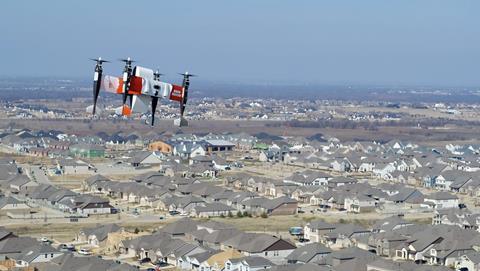Bell believes it will be able to design and build its Autonomous Pod Transport (APT) cheap enough for the unmanned air vehicle (UAV) to be considered attritable.
“Attritable” UAVs are intended to be so low cost that large quantities of the unmanned aircraft could be lost to combat attrition and then affordably replaced.

Bell’s APT is a family of tail-sitting UAVs that take off and land vertically and then cruise on a set of two wings. The UAVs are intended to fly cargo missions for the US military and commercial delivery services, such as UPS and FedEX.
Bell declines to say the APT’s price, but notes the UAV’s cost should be weighed against what it is replacing: resupply missions carried out by manned helicopter or ground vehicles.
“The unit cost for the vehicle is heavily dependent on the purchase quantities and the specific equipment that the customer might require,” says John Wittmaak, unmanned air system programme manager with Bell. “We are designing aircraft to be as low cost as possible. We’re trying to make it [with the] minimal number of parts and keep the technology component level as low as possible so that we can make this affordable to the soldiers and they’re not afraid to put it in harm’s way.”
For the second year in a row, the company demonstrated the APT system at the US Army’s Expeditionary Warfighter Experiment, a demonstration which took place in March at Fort Benning in Georgia.
“We provided unmanned aerial resupply missions to soldiers that were in those simulated combat exercises,” says Wittmaak. “We delivered everything from belted ammunition, to loose ammunition to food, water, and medical supplies.”
An APT variant demonstrated in December the ability to carry as much as 50kg (110lb) over 8.7nm (16.1km), the company says.
“We’ve done the design synthesis of the aircraft propulsion systems to payloads the size of [227kg],” says Wittmaak.
Bell decided to power the APT with a battery and four electric motors because it believes it will make the UAV simpler to use, more reliable and quieter, compared to an internal combustion engine, says Wittmaak.
“The benefits of electric [vertical take-off and landing UAVs] are the simplicity, the lack of maintenance, and the reduced level of skill required to operate the vehicle,” he says. “So that was the main reason why we pursued the eVTOL path in this case; to make it usable by infantry and soldiers with minimal levels of training.”
Mike Goodwin, unmanned air system sales and strategy manager with Bell, says batteries also offer room for growth.
“Public information released by the industries that are focused on making better batteries for the future, we see that they’re generally speaking about a 15% increase in power and efficiency year-on-year,” he says. “This technology, based on battery power, will only continue to get better as the years progress.”































